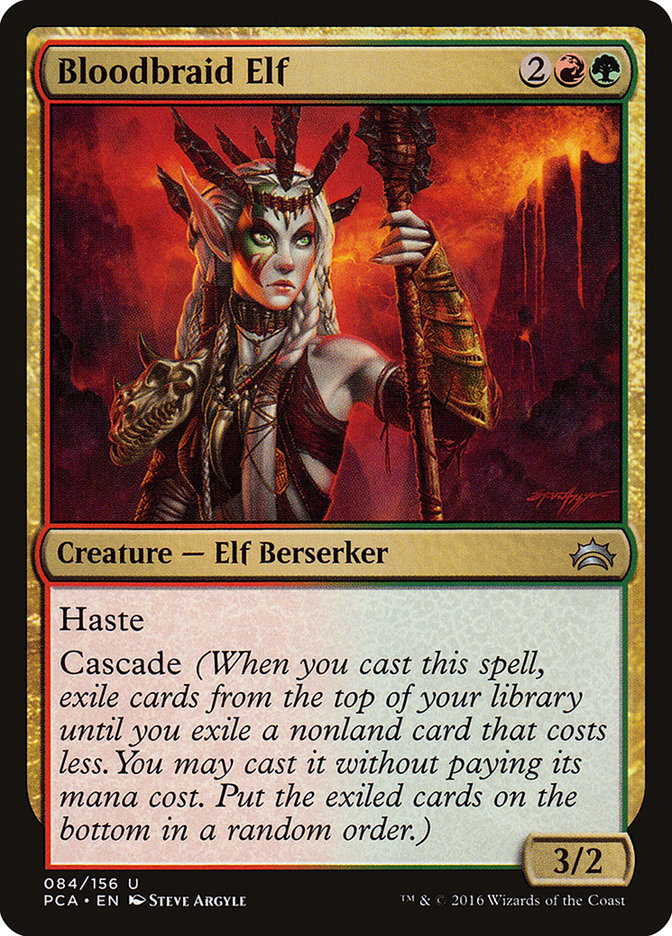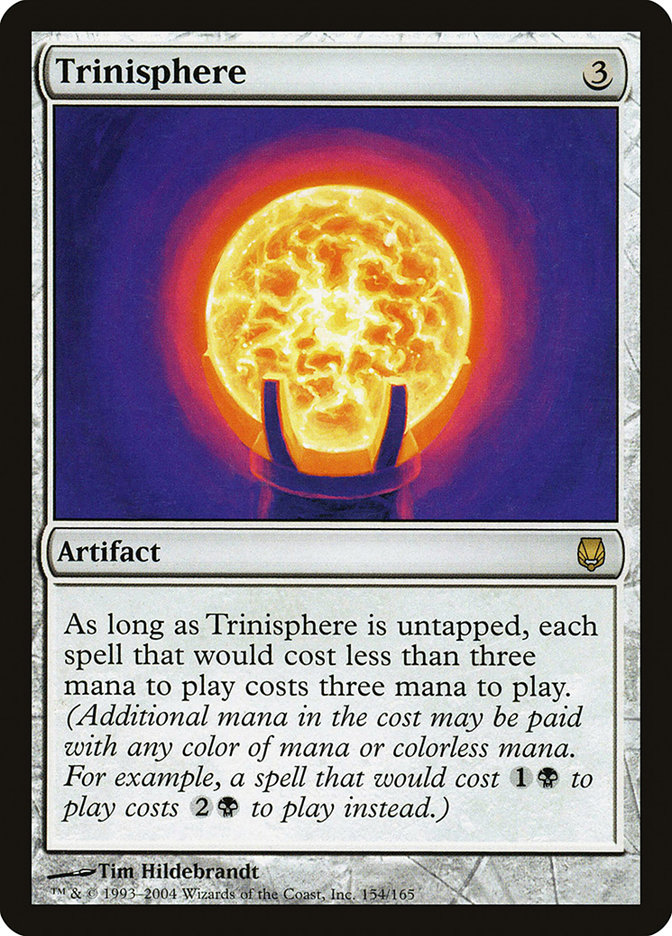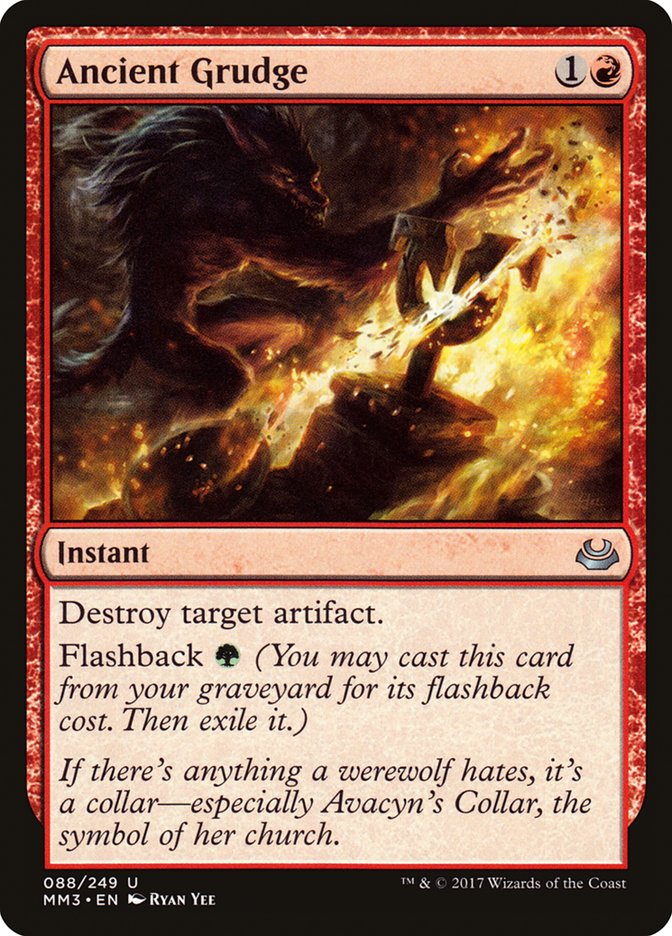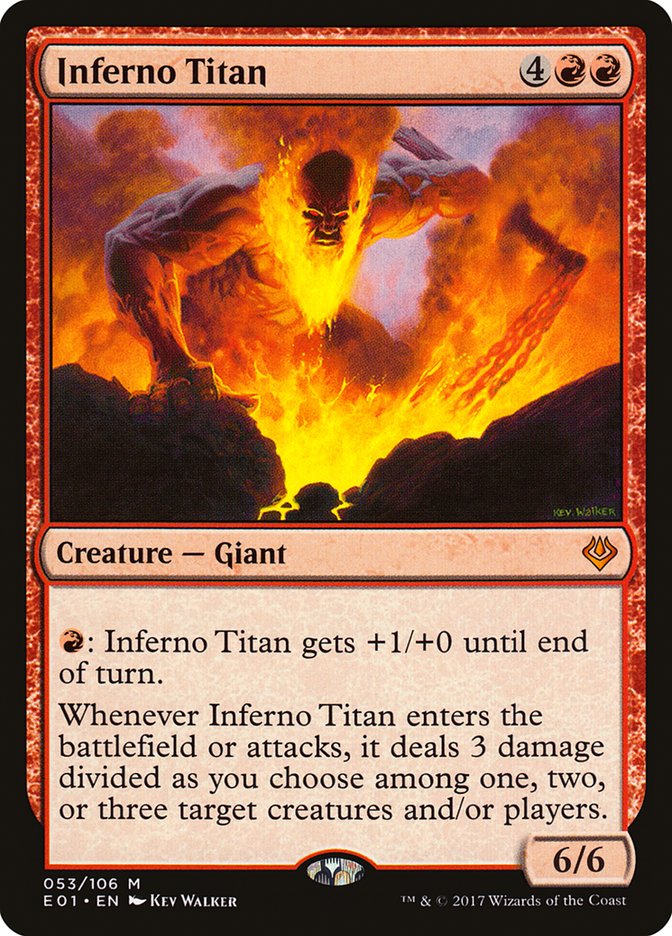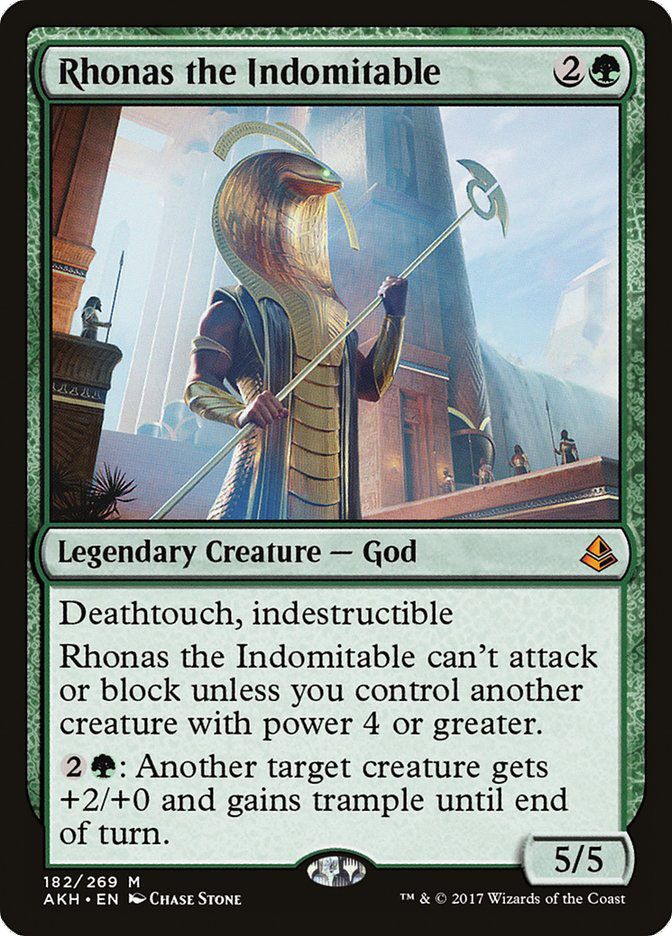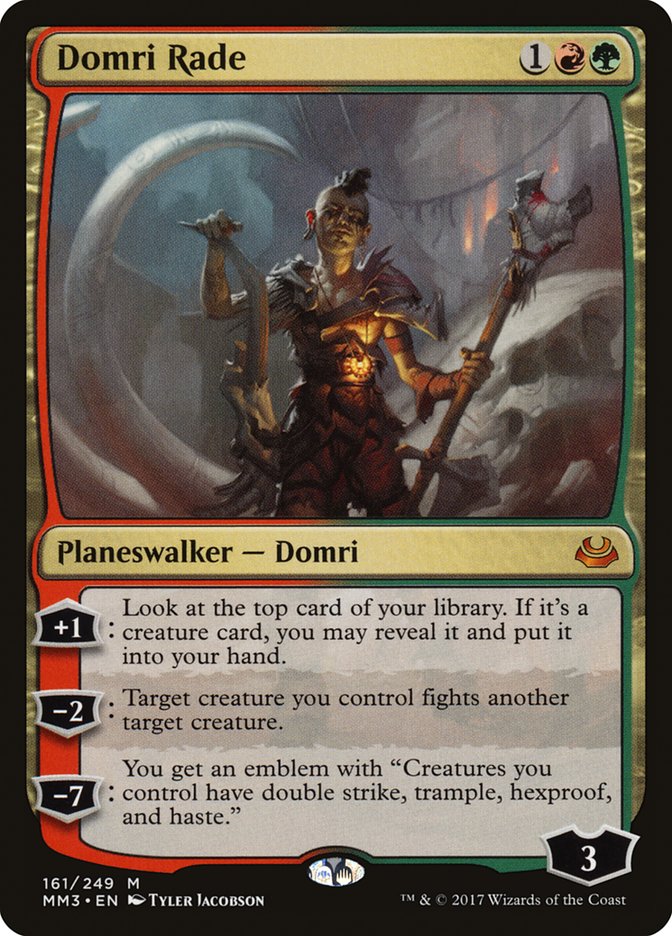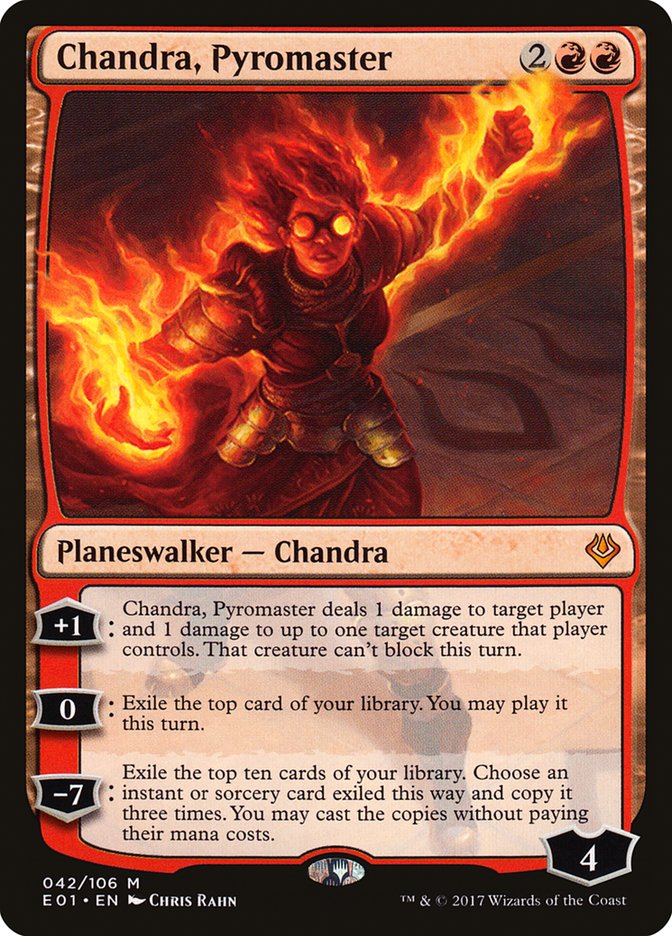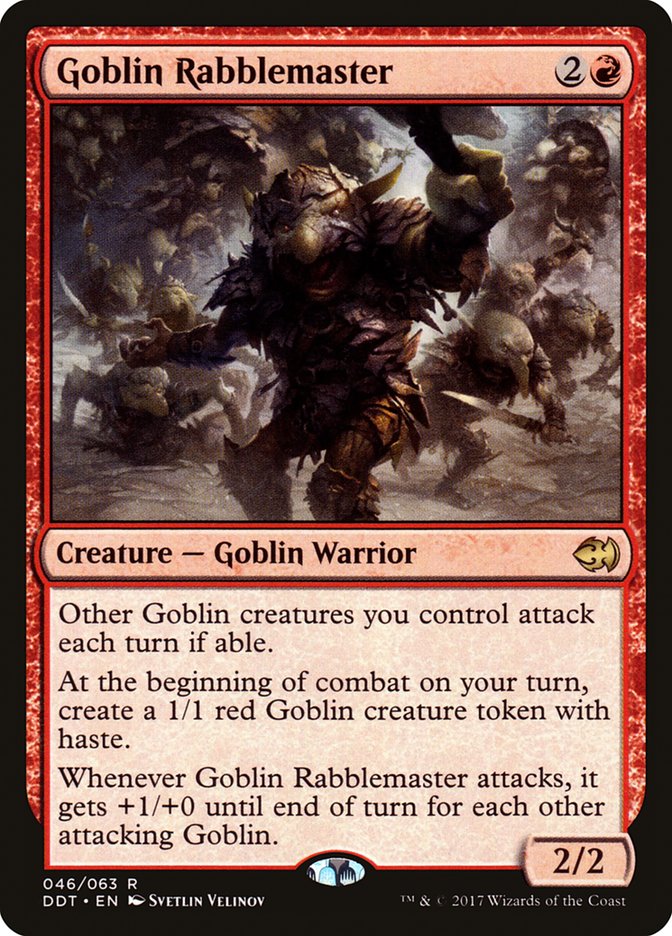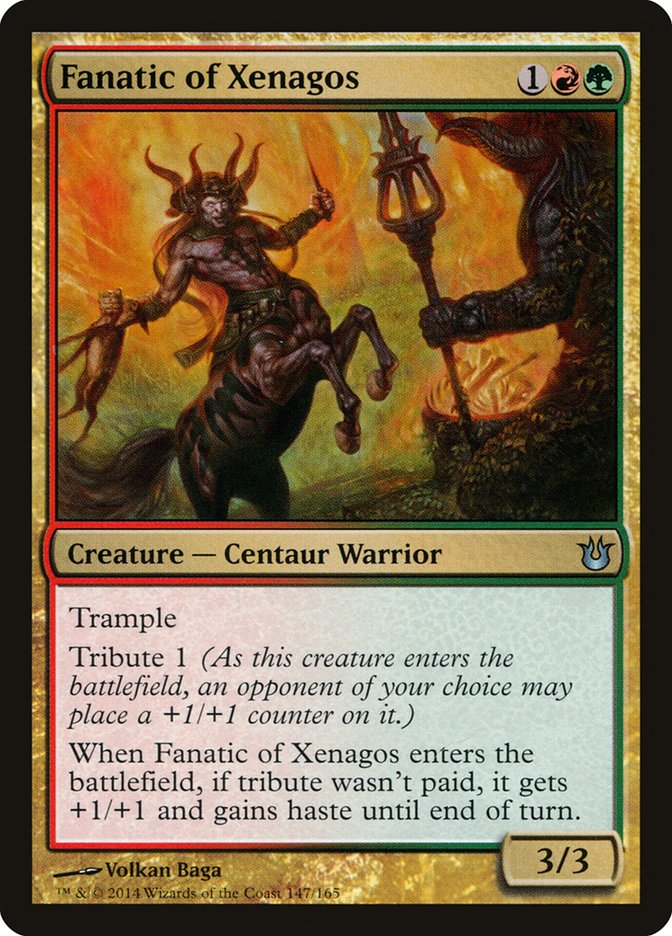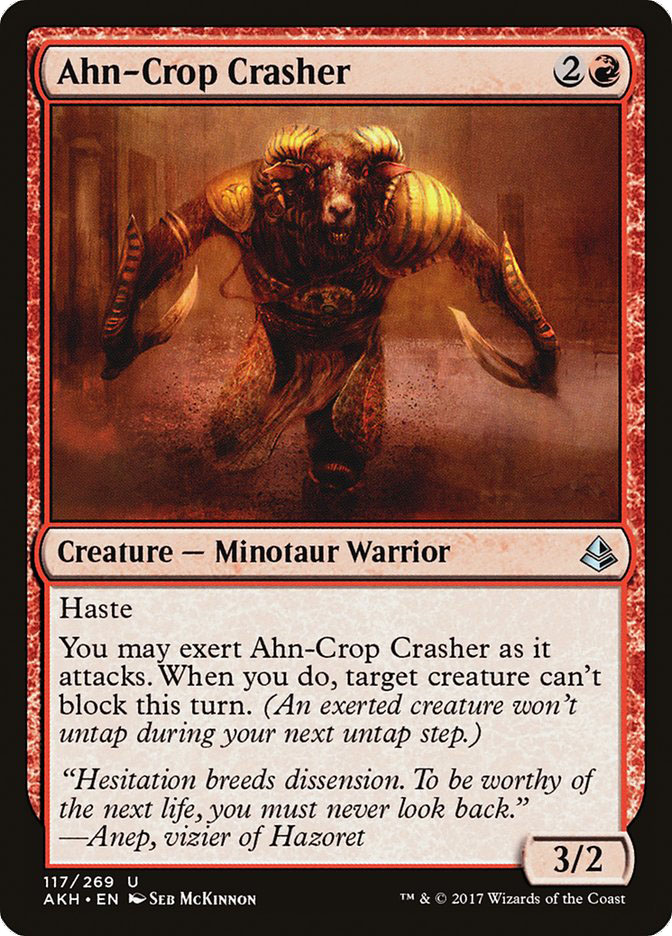This past weekend at #SCGDFW Andrew Wolbers
finished the swiss rounds as the one seed and then took down the tournament
with a unique choice that hasn’t traditionally seen much success on the SCG
Tour, G/R Ponza.
Creatures (20)
- 2 Birds of Paradise
- 4 Bloodbraid Elf
- 4 Arbor Elf
- 3 Inferno Titan
- 1 Courser of Kruphix
- 2 Pia and Kiran Nalaar
- 4 Tireless Tracker
Planeswalkers (2)
Lands (21)
Spells (17)

The goal of this strategy is to use one mana acceleration cards to power
out either Blood Moon or a land destruction spell on the second turn,
crippling the ability for the opponent to cast their spells. This is the
main focus of the deck, and it drastically increases the percentage of
games you play where you receive a “free-win,” something I’ll touch on
later in the article. From there, threats that can generate card advantage
take over the midgame, stretching the resources the opponent can use thin.
Finally at the top end there is Inferno Titan, which can single-handedly
help clear the opponent’s battlefield and finish off the game in as little
as one attack.
We haven’t seen G/R Ponza have success like this before on the SCG Tour for
a few reasons. It has a much higher mana curve than a typical Modern deck,
and therefore, incredibly relies on the ten turn-1 mana accelerants in
order to not be too slow out of the gate. Decks that can interact with this
turn-1 play while still putting up a fast clock, such as Burn or Grixis
Death’s Shadow, are traditionally favored in the matchup and have been very
popular deck choices in the recent past. The same goes for decks that can
ignore the manabase disruption elements of G/R Ponza and still win the game
quickly, such as Affinity, Humans, and U/R Gifts Storm. So with five of the
most popular decks in the format over the last year or so being rough
matchups for G/R Ponza, it makes sense we haven’t seen it have this kind of
dominating performance before. So what changed?
Considering the huge impact Bloodbraid Elf has had on the Modern format as
a whole, I don’t think any strategy has been more uplifted by the recently
unbanned Elf Berserker than G/R Ponza. The reason why is that it increases
the frequency of seeing the three mana land disruption spells, most notably
Blood Moon, while also providing a creature that either speeds up your own
clock or slows down the opponent long enough to bridge to Inferno Titan.
Getting Blood Moon onto the battlefield early is the number one goal in
almost every matchup for this deck, and Bloodbraid Elf increases your
chances of doing that. Also, each land destruction spell you cast makes the
next better, and Bloodbraid Elf also increases your ability to chain them
together.
The other thing Bloodbraid Elf helps with is the ability to find your
sideboard cards for these tough matchups. Trinisphere is not only a must
answer card from U/R Gifts Storm, it can also greatly slow down the
aggressive decks that are trying to empty their hand quickly. Similarly,
Anger of the Gods and Ancient Grudge are vital to winning matchups like
Elves or Affinity, and although Bloodbraid Elf doesn’t always hit the exact
card you want, the times it does will greatly improve your win percentage
that game. I don’t believe the addition of Bloodbraid Elf has
single-handedly made any of the aforementioned matchups necessarily
favorable for G/R Ponza, but it has absolutely increased the win percentage
it now has over all of them.
Every deck you play against in Magic, no matter the format, has some
percentage of the games where they will do hardly anything in terms of
casting cards to win, and this is known as their fail rate. The most common
scenarios a deck will fail and not put up much of a fight is after
mulliganing to a low number of starting cards, or when keeping a land heavy
or land light hand and not drawing the other part of the deck. What Blood
Moon does, in short, is drastically increase the fail rate of the
opponent’s deck by not allowing them to cast many of the spells drawn
throughout the game. This is compounded when you have the ability to play
Blood Moon on the second turn of the game with the help of mana
acceleration on turn one, as many opponents will be locked out of casting
their spells as soon as Blood Moon resolves.
This has made Blood Moon one of the most powerful cards in Modern for as
long as the format has been around, but over the past year it couldn’t find
the right shell around it. Decks like G/R Ponza that were trying to ramp
into Blood Moon to take advantage of its power were struggling when they
didn’t have an early Blood Moon. With Bloodbraid Elf now in the format,
however, ramping into Blood Moon is not only much more reliable, but it’s
also easier to have a proactive game plan around the Blood Moon. I’m
excited about the potential of G/R Blood Moon decks moving forward with the
addition of Bloodbraid Elf in the format, even though I’m still not sold
that the big version of G/R Ponza is exactly where you want to be. Let’s
take a look at some other options with these two cards that I’ve been
testing out recently:
Creatures (19)
Planeswalkers (1)
Lands (12)
Spells (28)

One of the first things I tried to do at the beginning of this format is to
make a smaller G/R Ponza deck work, with the theory being that instead of
having expensive cards like Inferno Titan stuck in your hand when you’re
light on mana, you would have access to efficient threats such as
Tarmogoyf. This was the decklist I gave a friend of mine leading up into
the Hunter Burton Memorial Open last month as a tool to fight the potential
blue decks built around Jace, the Mind Sculptor that we expected to see
play.
Unfortunately, after playing some leagues with the deck I believe that
having access to Inferno Titan is still the best thing the G/R Ponza decks
can do, as it takes over the game by itself after you slow them down in a
way that Tarmogoyf doesn’t. When devoting so many resources to disrupting
the opponent’s manabase to slow them down, having an individual threat that
takes over the game is vital, and that’s exactly what Inferno Titan does.
Tarmogoyf, on the other hand, is still vulnerable to removal spells like
Fatal Push and therefore, works better when it has more threats around it
as well, which lead me to trimming the land destruction spells in favor of
more low cost threats.
Creatures (25)
- 4 Birds of Paradise
- 4 Tarmogoyf
- 2 Kitchen Finks
- 4 Noble Hierarch
- 4 Bloodbraid Elf
- 3 Scavenging Ooze
- 1 Courser of Kruphix
- 2 Tireless Tracker
- 1 Rhonas the Indomitable
Planeswalkers (5)
Lands (13)
Spells (17)

I briefly touched on this deck
last week
, specifically about Nissa, Voice of Zendikar, which constantly over
performs, and although it’s still rough around the edges I think that it’s
quite close to being a deck I’m excited to register for a Modern Open. I
played this 75 in the Modern Classic at #SCGDFW last weekend to
a Top 32 finish after losing the last two rounds, but overall it felt
really good and this is exactly the type of deck that I want to abuse the
power of Blood Moon with moving forward. With the decklist admittedly rough
around the edges with plenty of pet cards I like, let’s see if we can tune
it some to help moving forward.
Let’s start with the card that has been the least impressive for me, Rhonas
the Indomitable. The thought behind playing a Rhonas was to help win
battlefield stalls and fight large creatures in conjunction with Domri
Rade. Turning on Rhonas to be able to attack and block isn’t the most
difficult, as Tarmogoyf and Scavenging Ooze are frequently four or more
power, and all of the three power creatures in the deck simply need a
Nissa, Voice of Zendikar minus ability to grow large enough. There have
certainly been games where Rhonas dominated the game with its activated
ability, but there have also been too many where it did virtually nothing
as each other creature was removed from the battlefield. Moving forward I’m
looking to cut Rhonas, as well as trim at least one Domri Rade, and
therefore, would still like more creature removal in the deck besides just
the four Lightning Bolts, most likely in the form of a Roast or a
Dismember.
I only played two Tireless Trackers and am undecided whether I want to add
any more. We saw the winning decklist have four Tireless Trackers, and many
people believe it’s one of the best cards to play in a deck such as this,
but I’m not sold on it. I believe Tireless Tracker is incredibly good in
the G/R Ponza deck still, but the impact that Bloodbraid Elf has had on the
speed of the format has made me wary of adding in more Tireless Trackers.
This deck can already grind well with other midrange decks besides having
the free wins from Blood Moon, and therefore, the matchups I’m most worried
about are U/R Gifts Storm, Humans, and Elves, all of which can overpower a
Tireless Tracker early.
I’m playing the Chandra that people don’t really expect to see, Chandra,
Pyromaster, and so far have been very pleased with the card, even though
two is probably too many. It does a wonderful job at keeping opponents from
going wide with one-toughness creatures, such as from Young Pyromancer,
Lingering Souls, or creatures in Elves and Humans. The plus ability also
makes their creature not able to block, which helps with racing situations
against a large threat that you can’t get through. Finally, the zero
ability also allows you to play lands from the top of the library which has
synergy with Tireless Tracker.
This is a deck I’m going to continue to tune with those difficult matchups
listed earlier in mind, but is a front-runner for the deck I’m going to
play at SCG Cincinnati, as getting out an early Blood Moon is exactly where
I want to be in this Bloodbraid Elf format. Another option though is to get
much more aggressive:
Creatures (32)
- 4 Tarmogoyf
- 4 Noble Hierarch
- 4 Bloodbraid Elf
- 4 Arbor Elf
- 3 Scavenging Ooze
- 4 Strangleroot Geist
- 3 Fanatic of Xenagos
- 4 Goblin Rabblemaster
- 2 Ahn-Crop Crasher
Lands (12)
Spells (16)

This version is looking to end the game quickly with plenty of haste
threats to go alongside Bloodbraid Elf, my favorite of which is
Strangleroot Geist, a much underappreciated two-drop. Not only does it
provide an immediate threat with having haste, but it also has undying,
which means it comes back larger than before after the first time it dies;
it’s perfect when all you want to do is attack and then attack some more.
Having a deck that’s built around attacking and ending the game quickly can
be the perfect pair to an early Blood Moon, slowing down the opponent
immensely.
Goblin Rabblemaster is a must-answer threat that can end the game very
quickly if left unchecked, which is exactly what you want after casting a
Blood Moon. It’s also a nice hit off of Bloodbraid Elf to add on damage
when you’re racing the big mana and combo decks. The 1/1 creatures it makes
can even crew Smuggler’s Copter for added synergy and when you don’t want
to be forced to attack on the ground. Even though it’s a three-drop that’s
weak to the most played card in the format, Lightning Bolt, there is enough
power that I’m excited to try out this G/R Aggro deck built around it.
The other three-drops I’m going with to start off are Fanatic of Xenagos
and Ahn-Crop Crasher, which are both also susceptible to Lightning Bolt,
not isn’t a fantastic position to be in. Hopefully though, with all of
these threats our opponent’s Lightning Bolts are overwhelmed. Fanatic of
Xenagos can be a 4/4 forever or a 4/4 with haste for one turn, depending on
which your opponent decides, and Ahn-Crop Crasher can exert to make their
best creature not be able to block as we’ve seen in Standard.
If nothing else, G/R Ponza winning #SCGDFW helped
demonstrate the power of playing Blood Moon on turn 2 backed by Bloodbraid
Elf, and it’s the thing I’m interested in utilizing moving forward. This
still leaves us with different options to explore, but finding the right
combination whether it’s aggro, midrange, or land destruction style could
be the key I’m looking for to get back on track in Modern at #SCGCIN.


